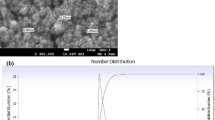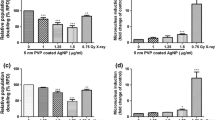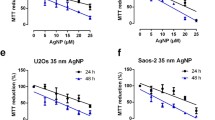Abstract
The present study was aimed at providing a better understanding of the influence of silver nanoparticles (AgNPs) on the p53 tumor suppressor protein. Cell line A549 was exposed to a range of concentrations of AgNPs, and a time course (up to 72 h) of cell viability was determined. We also determined the time course of gene and protein expression of p53, p21, murine double minute 2 (MDM2) and caspase-3. The expression of all of these proteins was also determined after daily exposure of the cells to 10 µg/mL of AgNPs for 7 days, or after discontinuous exposure by treating the cells every 3 days, for 15 or 30 days. Moreover, epigenetic changes in the acetylation of the histone H3 protein and in global DNA methylation patterns were determined after 72 h of exposure. Results showed that daily exposure to low doses of AgNPs, or a single exposure to high concentrations for 72 h, decreased gene and protein expression of p53, p21, MDM2 and caspase-3 in A549 cells. In contrast, a discontinuous exposure to low doses or a single exposure to low concentrations for 72 h increased the levels of the active forms of p53 and caspase-3, as well as the p21 and MDM2 protein levels. In addition, exposure to high concentrations of AgNPs for 72 h induced higher levels of global DNA methylation and global histone H3 deacetylation in A549 cells. These results provide new information on the toxic action of AgNPs.






Similar content being viewed by others
References
Ahamed M, Karns M, Goodson M, Rowe J, Hussain SM, Schlager JJ et al (2008) DNA damage response to different surface chemistry of silver nanoparticles in mammalian cells. Toxicol Appl Pharmacol 233:404–410
Albanese A, Chan WCW (2011) Effect of gold nanoparticle aggregation on cell uptake and toxicity. ACS Nano 5:5478–5489
Arora S, Jain J, Rajwade JM, Paknikar KM (2008) Cellular responses induced by silver nanoparticles: in vitro studies. Toxicol Lett 179:93–100
AshaRani PV, Mun GLK, Hande MP, Valiyaveettil S (2009) Cytotoxicity and genotoxicity of silver nanoparticles in human cells. ACS Nano 3:279–290
AshaRani P, Sethu S, Lim H, Balaji G, Valiyaveettil S, Hande MP (2012) Differential regulation of intracellular factors mediating cell cycle, DNA repair and inflammation following exposure to silver nanoparticles in human cells. Genome Integr 3:2
Austin LA, MacKey MA, Dreaden EC, El-Sayed MA (2014) The optical, photothermal, and facile surface chemical properties of gold and silver nanoparticles in biodiagnostics, therapy, and drug delivery. Arch Toxicol 88:1391–1417
Blaser SA, Scheringer M, MacLeod M, Hungerbühler K (2008) Estimation of cumulative aquatic exposure and risk due to silver: contribution of nano-functionalized plastics and textiles. Sci Total Environ 390:396–409
Böhmert L, Niemann B, Thünemann AF, Lampen A (2012) Cytotoxicity of peptide-coated silver nanoparticles on the human intestinal cell line Caco-2. Arch Toxicol 86:1107–1115
Braun GB, Friman T, Pang H-B, Pallaoro A, de Mendoza TH, Willmore A-MA et al (2014) Etchable plasmonic nanoparticle probes to image and quantify cellular internalization. Nat Mater 13:904–911
Chae YJ, Pham CH, Lee J, Bae E, Yi J, Gu MB (2009) Evaluation of the toxic impact of silver nanoparticles on Japanese medaka (Oryzias latipes). Aquat Toxicol 94:320–327
Choi AO, Brown SE, Szyf M, Maysinger D (2008) Quantum dot-induced epigenetic and genotoxic changes in human breast cancer cells. J Mol Med 86:291–302
Christen V, Capelle M, Fent K (2013) Silver nanoparticles induce endoplasmatic reticulum stress response in zebrafish. Toxicol Appl Pharmacol 272:519–528
Comfort KK, Maurer EI, Braydich-Stolle LK, Hussain SM (2011) Interference of silver, gold, and iron oxide nanoparticles on epidermal growth factor signal transduction in epithelial cells. ACS Nano 5:10000–10008
Comfort KK, Maurer EI, Hussain SM (2014) Slow release of ions from internalized silver nanoparticles modifies the epidermal growth factor signaling response. Colloids Surf B Biointerfaces 123:136–142
Costa CS, Ronconi JVV, Daufenbach JF, Gonçalves CL, Rezin GT, Streck EL et al (2010) In vitro effects of silver nanoparticles on the mitochondrial respiratory chain. Mol Cell Biochem 342:51–56
De Matteis V, Malvindi MA, Galeone A, Brunetti V, De Luca E, Kote S et al (2015) Negligible particle-specific toxicity mechanism of silver nanoparticles: the role of Ag + ion release in the cytosol. Nanomed Nanotech Biol Med 11:731–739
Devarajan E, Sahin A, Chen JS, Krishnamurthy RR, Aggarwal N, Brun A-M et al (2002) Down-regulation of caspase 3 in breast cancer: a possible mechanism for chemoresistance. Oncogene 21:8843–8851
Eom HJ, Ahn JM, Kim Y, Choi J (2013) Hypoxia inducible factor-1 (HIF-1)-flavin containing monooxygenase-2 (FMO-2) signaling acts in silver nanoparticles and silver ion toxicity in the nematode, Caenorhabditis elegans. Toxicol Appl Pharmacol 270:106–113
Foldbjerg R, Dang DA, Autrup H (2011) Cytotoxicity and genotoxicity of silver nanoparticles in the human lung cancer cell line, A549. Arch Toxicol 85:743–750
Gomez M, Esparza JL, Cabre M, García T, Domingo JL (2008) Aluminum exposure through the diet: metal levels in AβPP transgenic mice, a model for Alzheimer’s disease. Toxicology 249:214–219
Gong C, Tao G, Yang L, Liu J, Liu Q, Zhuang Z (2010) SiO2 nanoparticles induce global genomic hypomethylation in HaCaT cells. Biochem Biophys Res Commun 397:397–400
Greulich C, Diendorf J, Simon T, Eggeler G, Epple M, Köller M (2011) Uptake and intracellular distribution of silver nanoparticles in human mesenchymal stem cells. Acta Biomater 7:347–354
Guo Z, Kozlov S, Lavin MF, Person MD, Paull TT (2010) ATM activation by oxidative stress. Science 330:517–521
Guo D, Zhu L, Huang Z, Zhou H, Ge Y, Ma W et al (2013) Anti-leukemia activity of PVP-coated silver nanoparticles via generation of reactive oxygen species and release of silver ions. Biomaterials 34:7884–7894
He W, Zhou YT, Wamer WG, Boudreau MD, Yin JJ (2012) Mechanisms of the pH dependent generation of hydroxyl radicals and oxygen induced by Ag nanoparticles. Biomaterials 33:7547–7555
Islam KN, Mendelson CR (2006) Permissive effects of oxygen on cyclic AMP and interleukin-1 stimulation of surfactant protein A gene expression are mediated by epigenetic mechanisms. Mol Cell Biol 26:2901–2912
Jeyaraj M, Sathishkumar G, Sivanandhan G, MubarakAli D, Rajesh M, Arun R et al (2013) Biogenic silver nanoparticles for cancer treatment: an experimental report. Colloids Surf B Biointerfaces 106:86–92
Jiang X, Foldbjerg R, Miclaus T, Wang L, Singh R, Hayashi Y et al (2013) Multi-platform genotoxicity analysis of silver nanoparticles in the model cell line CHO-K1. Toxicol Lett 222:55–63
Kang K, Lim DH, Choi IH, Kang T, Lee K, Moon EY et al (2011) Vascular tube formation and angiogenesis induced by polyvinylpyrrolidone-coated silver nanoparticles. Toxicol Lett 205:227–234
Kim HR, Shin DY, Park YJ, Park CW, Oh SM, Chung KH (2014) Silver nanoparticles induce p53-mediated apoptosis in human bronchial epithelial (BEAS-2B) cells. J Toxicol Sci 39:401–412
Knudsen KB, Northeved H, Ek PK, Permin A, Andresen TL, Larsen S et al (2014) Differential toxicological response to positively and negatively charged nanoparticles in the rat brain. Nanotoxicology 8:764–774
Korani M, Rezayat SM, Arbabi Bidgoli S (2013) Sub-chronic dermal toxicity of silver nano particles in guinea pig: special emphasis to heart, bone and kidney toxicities. Iran J Pharm Res 12:511–519
Kovvuru P, Mancilla PE, Shirode AB, Murray TM, Begley TJ, Reliene R (2014) Oral ingestion of silver nanoparticles induces genomic instability and DNA damage in multiple tissues. Nanotoxicology 9:162–171
Kumar A, Dhawan A (2013) Genotoxic and carcinogenic potential of engineered nanoparticles: an update. Arch Toxicol 87:1883–1900
Lankoff A, Sandberg WJ, Wegierek-Ciuk A, Lisowska H, Refsnes M, Sartowska B et al (2012) The effect of agglomeration state of silver and titanium dioxide nanoparticles on cellular response of Hep G2, A549 and THP-1 cells. Toxicol Lett 208:197–213
Lee YS, Kim DW, Lee YH, Oh JH, Yoon S et al (2011) Silver nanoparticles induce apoptosis and G2/M arrest via PKCζ-dependent signaling in A549 lung cells. Arch Toxicol 85:1529–1540
Li Y, Bhalli JA, Ding W, Yan J, Pearce MG, Sadiq R et al (2013) Cytotoxicity and genotoxicity assessment of silver nanoparticles in mouse. Nanotoxicology 1:36–45
Lim HK, Asharani PV, Hande MP (2012) Enhanced genotoxicity of silver nanoparticles in DNA repair deficient mammalian cells. Front Genet 3:1–13
Liu W, Wu Y, Wang C, Li HC, Wang T, Liao CY et al (2010) Impact of silver nanoparticles on human cells: effect of particle size. Nanotoxicology 4:319–330
Maillard JY, Hartemann P (2012) Silver as an antimicrobial: facts and gaps in knowledge. Crit Rev Microbiol 39:373–383. doi:10.3109/1040841X.2012.713323
Mangini V, Dell’Aglio M, De Stradis A, De Giacomo A, De Pascale O, Natile G et al (2014) Amyloid transition of ubiquitin on silver nanoparticles produced by pulsed laser ablation in liquid as a function of stabilizer and single-point mutations. Chem Eur J 20:10745–10751
Mytych J, Pacyk K, Pepek M, Zebrowski J, Lewinska A, Wnuk M (2015) Nanoparticle-mediated decrease of lamin B1 pools promotes a TRF protein-based adaptive response in cultured cells. Biomaterials 53:107–116
Narayan PJ, Lill C, Faull R, Curtis MA, Dragunow M (2015) Increased acetyl and total histone levels in post-mortem Alzheimer’s disease brain. Neurobiol Dis 74:281–294
Ortega FG, Fernández-Baldó MA, Fernández JG, Serrano MJ et al (2015) Study of antitumor activity in breast cell lines using silver nanoparticles produced by yeast. Int J Nanomed 10:2021–2031
Pham CH, Yi J, Gu MB (2012) Biomarker gene response in male Medaka (Oryzias latipes) chronically exposed to silver nanoparticle. Ecotoxicol Environ Saf 78:239–245
Piao MJ, Kang KA, Lee IK, Kim HS, Kim S, Choi JY et al (2011) Silver nanoparticles induce oxidative cell damage in human liver cells through inhibition of reduced glutathione and induction of mitochondria-involved apoptosis. Toxicol Lett 201:92–100
Rivlin N, Brosh R, Oren M, Rotter V (2011) Mutations in the p53 tumor suppressor gene: important milestones at the various steps of tumorigenesis. Genes Cancer 2:466–474
Robinson CM, Neary R, Levendale A, Watson CJ, Baugh JA (2012) Hypoxia-induced dna hypermethylation in human pulmonary fibroblasts is associated with thy-1 promoter methylation and the development of a pro-fibrotic phenotype. Respir Res 13:74
Sarhan OMM, Hussein RM (2014) Effects of intraperitoneally injected silver nanoparticles on histological structures and blood parameters in the albino rat. Int J Nanomed 9:1505–1517
Satapathy SR, Mohapatra P, Preet R, Das D, Sarkar B, Choudhuri T et al (2013) Silver-based nanoparticles induce apoptosis in human colon cancer cells mediated through p53. Nanomedicine 8:1307–1322
Satapathy SR, Mohapatra P, Das D, Siddharth S, Kundu CN (2014) The apoptotic effect of plant based nanosilver in colon cancer cells is a p53 dependent process involving ROS and JNK cascade. Pathol Oncol Res 21:405–411
Schluesener JK, Schluesener HJ (2013) Nanosilver: application and novel aspects of toxicology. Arch Toxicol 87:569–576
Seal S, Karn B (2014) Safety aspects of nanotechnology based activity. Saf Sci 63:217–225
Sharma VK, Siskova KM, Zboril R, Gardea-Torresdey JL (2014) Organic-coated silver nanoparticles in biological and environmental conditions: fate, stability and toxicity. Adv Colloid Interface Sci 204:15–34
Singh RP, Ramarao P (2012) Cellular uptake, intracellular trafficking and cytotoxicity of silver nanoparticles. Toxicol Lett 213:249–259
Song KS, Sung JH, Ji JH, Lee JH, Lee JS, Ryu HR et al (2013) Recovery from silver-nanoparticle-exposure-induced lung inflammation and lung function changes in Sprague Dawley rats. Nanotoxicology 7:169–180
Sriram MI, Kanth SBM, Kalishwaralal K, Gurunathan S (2010) Antitumor activity of silver nanoparticles in Dalton’s lymphoma ascites tumor model. Int J Nanomed 5:753–762
Sun X, Wang Z, Zhai S, Cheng Y, Liu J, Liu B (2013) In vitro cytotoxicity of silver nanoparticles in primary rat hepatic stellate cells. Mol Med Rep 8:1365–1372
Tan JW, Ho CF, Ng YK, Ong WY (2014) Docosahexaenoic acid and l-Carnitine prevent ATP loss in SH-SY5Y neuroblastoma cells after exposure to silver nanoparticles. Environ Toxicol 31(2):224–232
Tolaymat TM, El Badawy AM, Genaidy A, Scheckel KG, Luxton TP, Suidan M (2010) An evidence-based environmental perspective of manufactured silver nanoparticle in syntheses and applications: a systematic review and critical appraisal of peer-reviewed scientific papers. Sci Total Environ 408:999–1006
Xu L, Shi C, Shao A, Li X, Cheng X, Ding R, Wu G, Chou LL (2014) Toxic responses in rat embryonic cells to silver nanoparticles and released silver ions as analyzed via gene expression profiles and transmission electron microscopy. Nanotoxicology 9:513–522
Zhang T, Wang L, Chen Q, Chen C (2014) Cytotoxic potential of silver nanoparticles. Yonsei Med J 55:283–291
Acknowledgments
The authors thank the Pharmacology, Lipids and Arteriosclerosis Research, Histology and Neurobiology Units of the School of Medicine, Universitat Rovira i Virgili, Reus, Spain, for their skillful technical support.
Author information
Authors and Affiliations
Corresponding author
Ethics declarations
Conflict of interest
The authors declare that there are no conflicts of interest.
Electronic supplementary material
Below is the link to the electronic supplementary material.
Rights and permissions
About this article
Cite this article
Blanco, J., Lafuente, D., Gómez, M. et al. Polyvinyl pyrrolidone-coated silver nanoparticles in a human lung cancer cells: time- and dose-dependent influence over p53 and caspase-3 protein expression and epigenetic effects. Arch Toxicol 91, 651–666 (2017). https://doi.org/10.1007/s00204-016-1773-0
Received:
Accepted:
Published:
Issue Date:
DOI: https://doi.org/10.1007/s00204-016-1773-0




